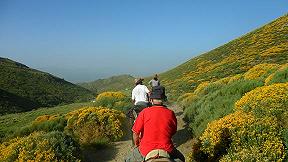The Cañada Real Leonesa Occidental ( Western Royal Drovers’ Road of Leon) extends over 700 kilometers from León to Badajoz. It starts near the city of León and, before crossing the Duero in the vicinity of Tordesillas, it crosses the moors of Valencia de Don Juan and Sahagun to reach Medina de Rioseco. Once The Cañada leaves the land of Medina del Campo, it goes to La Morana (province of Ávila) through Muñico in the Sierra de Ávila and the Port of Menga in the Serrota. Sierra de Gredos mountains is crossed by the Pico Pass descending towards Valley of Tiétar in Extremadura.
The route proposed by Gredos Ecuestre crosses the Western Cañada Real Leonesa (Royal Drovers’ Road of Leon) from South to North within the province of Ávila. The tracks in this route are impressive with constant changes on the nature and landscapes crossed; forms of traditional architecture adapted to these environments; lifestyles and agro-livestock resources.

Trashumancia
Arenas de San Pedro-San Martín del Pimpollar
The route begins in the foothills of Valley of Tiétar, in the town of Arenas de San Pedro. The microclimate of this region favors all kinds of Mediterranean crops (olives, figs, vines) and plantations of chestnut, oak, cherry and all kinds of fruit trees. The tour crosses the town of Mombeltrán; dominated by its castle (XV century) and the parish church (XIV century). It is the capital of the Barranco de las Cinco Villas Gredos (the Gully of the Five Towns of Gredos) giving access to the Puerto del Pico (Pico Pass). The ascent to this port is done following the path of the Roman Road, which is still in fair condition, after passing through the beautiful town of Cuevas del Valle. Descending to San Martin del Pimpollar, we turn the other cattle route, the track of Barco de Ávila, which runs along grass highlands where nomadic livestock spends the summer months coming from Extremadura.
The landscape changes completely. The lush vegetation disappears, and the slopes are less deep. Many streams cross the meadows and the piorno, typical shrub of this altitude, dominates the horizon.
San Martín del Pimpollar-Narros del Puerto
The second day will take us through the course of the newborn Alberche River to the Valley of Amblés. Livestock region per excellence, the tough winters make cattle the only possible economic resource. We find here stunning mountain landscapes with plenty of aromatic, pure, clean air. Amblés valley is reached from the pass of Mengamuñoz.
At the bottom of the vallery is the town of the same name of medieval origin. Its name comes from the legends whose protagonists are the first settlers of the city of Ávila: Menga Muñoz was the wife of Jimeno Blázquez, Mayor and Governor of Ávila , father of the famous knight Nalvillos Blázquez. The village lies strategically within the Royal Road and the Royal Drovers’ Road of Leon.

Alberche River
Narros del Puerto-Santo Tomé de Zabarcos
The transition between the Valley of Amblés and the region of Morana is done through the Sierra de Ávila. Small towns like La Torre, Sanchicorto, Sanchorreja and Gallegos de Altamiros are being left abandoned through time by the cease of agricultural and livestock activities. It is a steppe landscape; hard, with lots of granite stones anarchically spread out the horizon.
Horse riders feel like entering into another era in where time did not matter and traveling long distances was done enjoying the colors and scents of chamomile, lavender or thyme.
Santo Tomé de Zabarcos-Arévalo
This is the longest and flattest track. The landscape is overwhelming with vast horizons and gentle wavy hills. Depending on the time of year the predominant color varies from cereal to the ochre of the newly plowed land.
In this region of La Moraña, the Drovers’ Road occasionally becomes an infinite straight line; linking towns to another town, a church, a chapel or a dovecote.; sandy soil that gives shelter to many hares and rabbits, resin pines, cereals fields and all kinds of grain, beetroot or sunflower.
Our route ends up in Arévalo, capital of La Moraña. With centuries of history collected within the stones of its walls, churches and chapels. Arévalo needs time to be explored. Thus, we will spend the morning of the 5th day to walk the streets and hidden corners.
Trip summary:
Trip length: 5 nights- 5 days (Sunday to Friday)
Distance covered: 126 km
Best time to visit: March to October
Group size: Minimun 2 riders, maximun 8 riders
Riding ability: Intermediate to experienced
Tack: Spanish work saddle
Time in the saddle: From 5 and 1⁄2 to 6 and 1⁄2 hours (one day)
Weight limit: 95 kgs
Price: 850€
This slideshow requires JavaScript.














